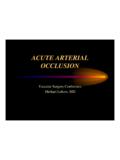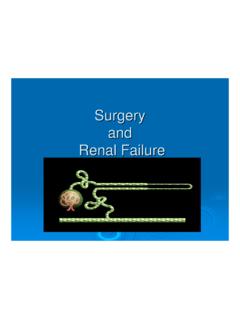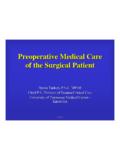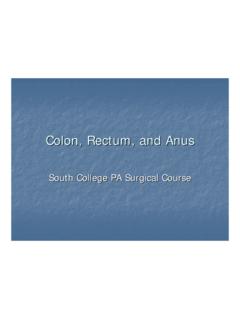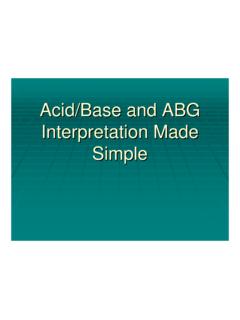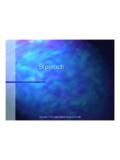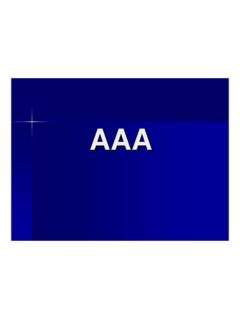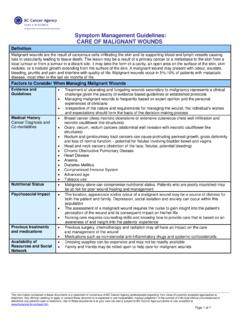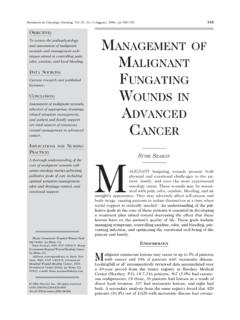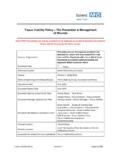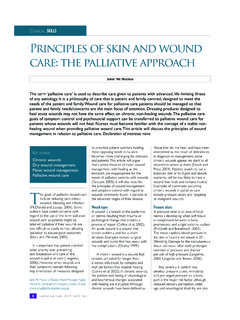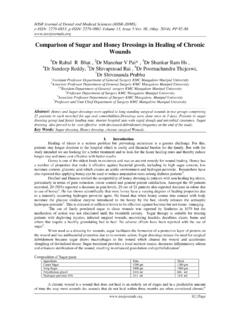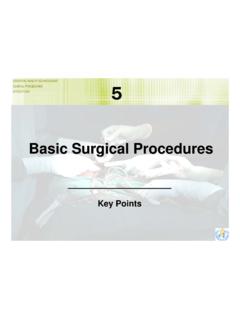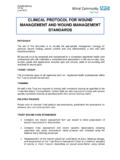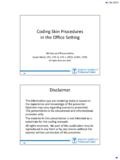Transcription of Wound Healing - University of Tennessee College …
1 Wound HealingWound HealingSouth College PA CourseUniversity of Tennessee Medical Center at KnoxvilleSouth College PA CourseUniversity of Tennessee Medical Center at KnoxvilleWound Healing For I am fearfullyand my soulknowethright well ~ Ps. 139 :14~ Wound HealingWound HealingWound HealingEdwin Smith Papyrus~ 1650 HealingEbers Papyrus~ 1550 Acute of Healing Coagulation Inflammation Proliferation of Healing Cellualar/mechanical constituents Neutrophils Macrophages Fibroblasts Collagen Chemical/cytokine Affecting Wound Healing Extrinsic States Impaired vsexcessive Healing Organ specific problems Genetic Options Local Wound care Skin replacement/ adjuncts New horizonsWound Healing Acute Wounds Chronic Wounds Diabetic Arterial Venous Pressure relatedWound Healing Chronic Wounds >3 mos. to heal repeated trauma/ poor perfusion/ ongoing inflammation Potential for malignant degeneration ( Marjolin sulcer) Wound Healing Chronic Wounds/ Diabetic Etio: Ischemia, neuropathy (motor/sensory), deformity ( Charcot s foot) Tx: blood Glucose control, R/O osteo, off load deformities, adequate debridementWound Healing Chronic Wounds/ Arterial Etio: inadequate perfusion S/S: Painful, dry, punctatevs.
2 Venous stasis Tx: Restablishmentof adequate flow + Wound careWound Healing Chronic Wounds/ Venous Etio: Hydrostatic pressure/ transudation/ fibrin polymerization/ perivascularcuffing S/S: Medial ankle, moist, superficial, diffuse vsarterial Tx: Elevation/ compression/ pain control (catecholamine response) Wound Healing Chronic Wounds/ Pressure sores Etio: capillary compression Classification NatnL. Pressure Ulcer Advisory Panel Stage I: skin intact Stage II: epidermal/dermal skin breakdown Stage III: ST loss down to but not through fascia Stage IV: extensive destruction through fascialplane Tx: debridement, Wound care, offloading pressure, grafting/flapsWound Healing Fibroblasts Migration by 3rdday/ dominant cell by 5thday GAG synthesis Collgaensynthesis Elucidate MMPsWound HealingWound Healing Angiogenesis Low O2tension/ elevated lactic acid concentration VGEF, aFGF& bFGFas per macrophages/endothelial cells/ fibroblasts Endothelial migration in accord w/ chemotacticgradient by collagenases Organization / Type IV collagen / basement membrane granulation tissue formation/ ground substance & high HA contentWound HealingWound Healing Phases of Healing / Proliferation (3 days-3 weeks) Fibroblast migration Via PDGF/TGF-B direction ECM interplay facilitated by fibronectin Heralds transition from inflammatory to reconstructive phase Collagen Synthesis Properties Process RegulationWound Healing Collagen Properties Most abundant protein in body 19 variants w/ Type I predominant Types II, III, IV, V High glycinecontent (q3)
3 Unique AA s 4-hydroxyproline 5-hydroxylysineWound Healing Collagen Synthesis/ Regulation Intracellular synthesis Triple helix w/ H bond linking Post trans oxidation prolinelysine VitC crucial for prolyl/lysylhydroxylase Propeptideprevention of aggregation EC secretion of procollagen Terminal propeptidescleaved tropocollagen Tropocollagenlimking collagen Via Cu-dependent lysine oxidaseWound Healing Collagen Synthesis Regulation Max accumulation by 2-3 wks total content = after 3 wks Pro: Acidemia TGF-B Hypoxia Inhibitory: NAD+/ ADP riboseWound Healing Phases of Healing / Maturation (3 weeks-6 months) Tensile strength: Per fibril cross-linking 50% @ 6 wks eventually ~70-80% @ 6 months Contraction: myofibroblast/actinfibers w/in 30-90% reduction in CSA Max rate mm/ day Reepithelialization: facilitated by contraction from peripheral basal margins inward Type IV collagen/basement membrane per keratinocytes Max rate 1-2mm/day Wound Healing CytokinesCytokines

